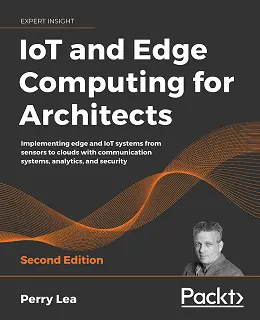IoT and Edge Computing for Architects – Second Edition

eBook Details:
- Paperback: 632 pages
- Publisher: WOW! eBook (March 6, 2020)
- Language: English
- ISBN-10: 1839214805
- ISBN-13: 978-1839214806
eBook Description:
IoT and Edge Computing for Architects, 2nd Edition: Implementing edge and IoT systems from sensors to clouds with communication systems, analytics, and security
Industries are embracing Internet of Things (IoT) technologies to improve operational expenses, product life, and people’s well-being. An architectural guide is needed if you want to traverse the spectrum of technologies needed to build a successful IoT system, whether that’s a single device or millions of IoT devices.
IoT and Edge Computing for Architects, Second Edition encompasses the entire spectrum of IoT solutions, from IoT sensors to the cloud. It examines modern sensor systems, focusing on their power and functionality. It also looks at communication theory, paying close attention to near-range PAN, including the new Bluetooth 5.0 specification and mesh networks. Then, the book explores IP-based communication in LAN and WAN, including 802.11ah, 5G LTE cellular, Sigfox, and LoRaWAN. It also explains edge computing, routing and gateways, and their role in fog computing, as well as the messaging protocols of MQTT 5.0 and CoAP.
- Understand the role and scope of architecting a successful IoT deployment
- Scan the landscape of IoT technologies, from sensors to the cloud and more
- See the trade-offs in choices of protocols and communications in IoT deployments
- Become familiar with the terminology needed to work in the IoT space
- Broaden your skills in the multiple engineering domains necessary for the IoT architect
- Implement best practices to ensure reliability, scalability, and security in your IoT infrastructure
With the data now in internet form, you’ll get an understanding of cloud and fog architectures, including the OpenFog standards. The book wraps up the analytics portion with the application of statistical analysis, complex event processing, and deep learning models. The book then concludes by providing a holistic view of IoT security, cryptography, and shell security in addition to software-defined perimeters and blockchains.

![Mastering Visual Studio 2019 [Video]](https://www.wowebook.org/wp-content/uploads/2019/09/Mastering-Visual-Studio-2019-Video.jpg)
![Building Mobile Apps with Ionic 4 [Video]](https://www.wowebook.org/wp-content/uploads/2019/10/Building-Mobile-Apps-with-Ionic-4-Video.jpg)
